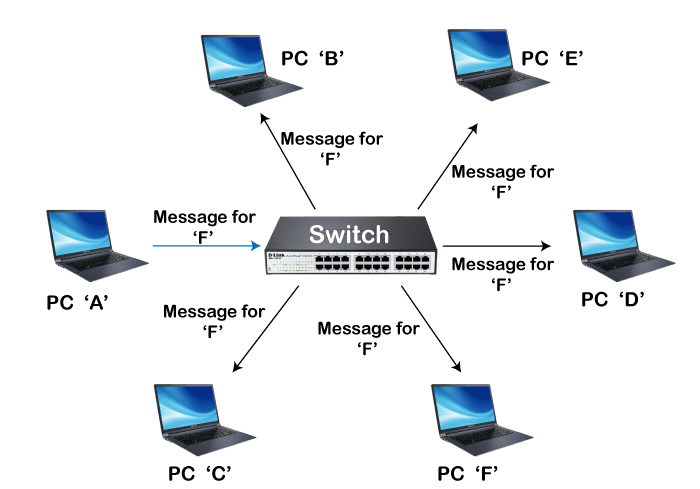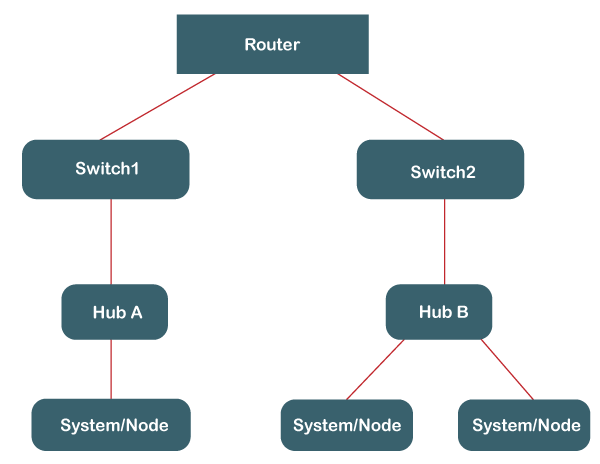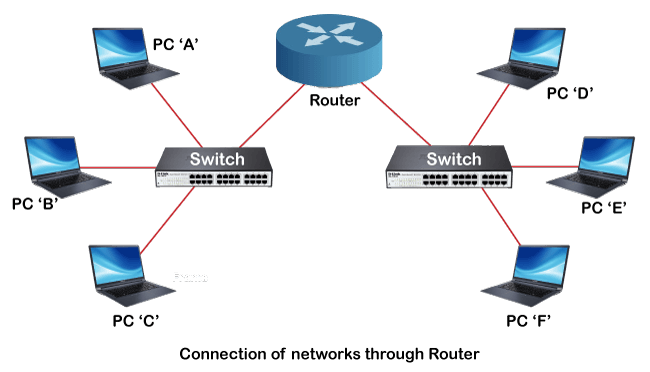Switch Vs. Router | Difference between Switch and Router
The switch and router are the two essential components of a network. Although both are the connecting devices in a network, and sometimes people assume them as the same, both have different functionality. In this topic, we will see how the switch and router are differentiated from each other.
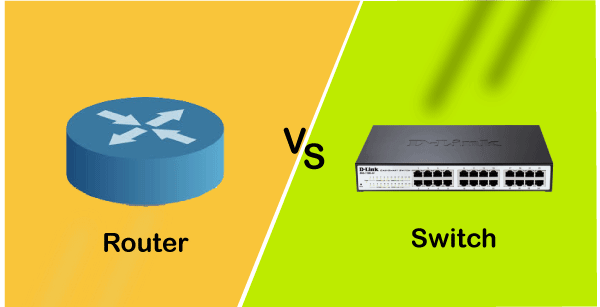
What is a Switch?
- A switch is a networking device, which provides the facility to share the information & resources by connecting different network devices, such as computers, printers, and servers, within a small business network.
- With the help of a switch, the connected devices can share the data & information and communicate with each other.
- Without a switch, we cannot build a small business network and cannot connect devices within a building or campus.
Types of Switch
There are mainly two types of switches in the network, which are given below:
- Unmanaged Switches
The unmanaged switches are mainly used for basic connectivity. These are mostly used in small networks or wherever only few more ports are required, such as at home, in a lab, or in a conference room. In unmanaged switches, there is no requirement for any configuration, which means by just plugging in, they will work. - Managed Switches
Managed switches are more secure than unmanaged switch, and provide other features and flexibility because we can easily configure them to custom-fit our network. Hence, we can have the greater control, and can also better protect our network and improve service quality for those who access the network.
How does a switch work?
As we know, each networking device contains a unique MAC (Media Access Control) address. When a device or computer sends an IP packet to another device, then switch put the IP packet with source MAC address and destination MAC address, and encapsulate it with a Frame, and then send it to another device.
When Frame reaches the destination device, it is stripped, and the device gets the IP packets and reaches only that device, which matches the entered destination MAC address.
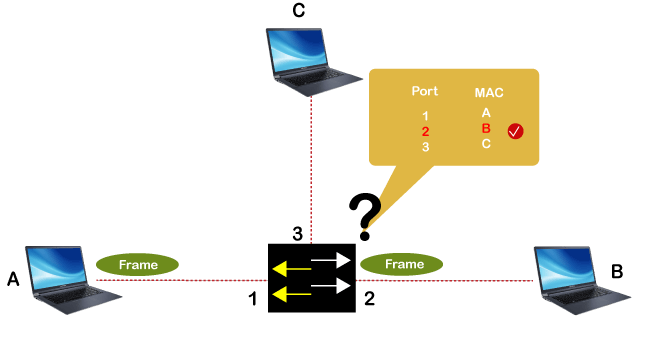
Advantages of Switch
- It enhances the available bandwidth of the network.
- It can be directly connected to the workstations or devices.
- Enhances the performance of the network.
- Networks with switches have less frame collision, and it is because switches develop the collision domain for each network.
- It helps in reducing the workload on the individual host such as PCs.
What is a Router?
- A router is a networking device used to connect multiple switches and their corresponding networks to build a large network. These switches and their corresponding networks may be in a single location or different locations.
- A router is an intelligent device and responsible for routing the data packets from source to destination over a network. It also distributes or routes the internet connection from modem to all the networking devices either wired or wireless, such as PC, Laptop, Mobile phone, tablet, etc
- It mainly performs two functions;
- Creating and maintaining the local area network,
- Managing the entering & leaving data.
- The router connects multiple networks and allows the networked devices & users to access the internet.
- It works on the network layer & route the data packets through the shortest path across the network.
Working of a Router
- Within a home or office, we have various networked devices such as PC, tablets, printers, etc., and with the router, these devices can be connected to the internet and form a network. A router first connects the modem to other devices to allow communication between these devices and the internet.
- Router routes/transmit the data packets with the defined IP address from one network to another or within a network. It does it by providing a local IP address to each device over the internet; it ensures the right destination so that data reach the right place rather than lost within the network.
- It finds out the best and fastest path and then sends data packets from that path to the devices connected within the network.
- It works similar to the delivery package with a defined address to reach the right recipient only.
Types of Router
There are mainly two types of the router, which are given below:
1. Wireless Router
- Wireless routers are the most commonly used routers in offices and homes as they don’t need any wire or cable to connect with networking devices.
- It provides a secure connection, and only authenticated users can access the network using the id & password.
- Using wireless router, internet can be accessed by the n number of users within the specified range.
2. Wired Router/Broadband Router
- As its name suggests, it requires a wire or cable to connect to the network devices.
- Such routers are mostly used in schools or small offices to connect the PCs with the Ethernet cable.
- It also has a Wi-fi access point, and a mobile phone can be connected to it using the VOIP (Voice-over-Internet Protocol) technology.
- It is connected to the ADSL modems to take the transmission data from the modem and distribute it to a further network.
Advantages of Router
- The wireless routers are mostly used that enable most networking devices to connect easily at any time, without the worry of a bunch of wires.
- It can connect with the different architecture of the network, such as Ethernet cable, Wi-fi, or WLAN.
- It provides highly secure network access with password protection.
- It reduces the network traffic with the help of the collision feature.
- It provides data packets to the correct destination with the best route using the routing table and intelligence.
Key Differences between the Switch & Router
- The main function of a switch is to connect the end devices such as computers, printers, etc., whereas the main function of a router is to connect two different networks.
- A switch works on the data link layer of the OSI model; on the other hand, a router works on the network layer of the OSI model.
- The switch aims to determine the destination address of the received IP packet and forward it to the destination address. On the other hand, the router’s main purpose is to find the smallest and best routes for the packets to reach the destination, determined using the routing table.
- There are various switching techniques such as circuit switching, packet switching, and message switching, which are used by a switch. In comparison, a router uses two routing techniques, which are adaptive routing and non-adaptive routing techniques.
- A switch stores MAC address in the lookup table or CAM table to get the source and destination addresses. In contrast, routers store the IP addresses in the routing table.
Difference Chart between Switch and Router
| Switch | Router |
|---|---|
| It connects multiple networked devices in the network. | It connects multiple switches & their corresponding networks. |
| It works on the data link layer of the OSI model. | It works on the network layer of the OSI model. |
| It is used within a LAN. | It can be used in LAN or MAN. |
| A switch cannot perform NAT or Network Address Translation. | A router can perform Network Address Translation. |
| The switch takes more time while making complicated routing decisions. | A router can take a routing decision much faster than a switch. |
| It provides only port security. | It provides security measures to protect the network from security threats. |
| It comes in the category of semi-Intelligent devices. | It is known as an Intelligent network device. |
| It works in either half or full-duplex transmission mode. | It works in the full-duplex transmission mode. However, we can change it manually to work on half-duplex mode. |
| It sends information from one device to another in the form of Frames (for L2 switch) and the form of packets (for L3 switch). | It sends information from one network to another network in the form of data packets. |
| Switches can only work with the wired network. | Routers can work with both wired & wireless networks. |
| Switches are available with different ports, such as 8, 16, 24, 48, and 64. | A router contains two ports by default, such as Fast Ethernet Port. But we can also add the serial ports explicitly. |
| It uses the CAM (Content Addressable Memory) table for the source and destination MAC address. | It uses the routing table to get the best route for the destination IP. |
Conclusion
As per the above discussion, we can conclude that both are important devices for setting up a network and both have their own significance in the network. However, to set up a home-based network and connect devices, we need a switch, and to connect two networks, we need a router.

